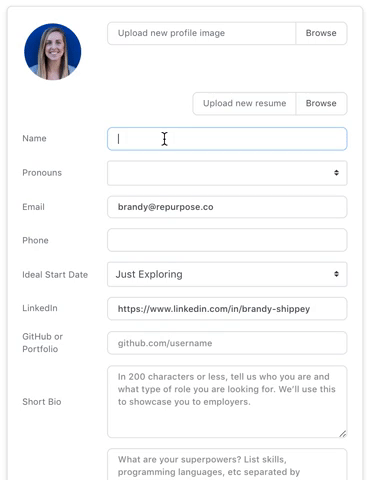We have some big news. As of today, the re:purpose platform now gives candidates the opportunity to display the pronouns they want to be addressed by.

Why? Because the way we choose to identify ourselves is important and a matter of human dignity. We believe respectfully addressing individuals goes beyond knowing their names, so we decided to make a change.
Interested to learn more about pronouns and how to use them? Let's dive in.
So, what are we talking about?
Some of us grew up with concrete pronouns to identify who we are, commonly within the U.S., associating feminine individuals with she/her pronouns and masculine individuals with he/him.
Gender-neutral pronouns like they/them, allow us to address individuals with non-specific words no matter if the subject is female or male.
Cool, and remind me why it matters?
You know the feeling when someone calls you by the wrong name? Think, Bryan instead of Ryan. While the speaker might not intend to misidentify, it's common to be frustrated by it. Everyone has an identity, and for most, gender identity is an important part of who they are.
Still unsure? Think of it this way: For centuries, "he" has been the go-to when addressing generic or hypothetical individuals. By swapping "he" for "they," you allow for more people to be included in a train-of-thought.
Can you give me an example?
Picture yourself in a meeting with your team. You're discussing bringing on a new hire and you ask your boss what they're (see what we did here) looking for in a candidate. If your boss refers to all prospective candidates as "he", you may think it's required to hire a man. By referring to unknown individuals and multi-gendered groups as they, you leave the door open to opportunities for everyone.
Great, so how do I use them?
Taking the first step is simple. As an individual, adding your pronouns to your LinkedIn or email signature is a great start. As an employer, giving candidates the opportunity to select the pronouns they want to be addressed by is a good first step. It's all about ensuring people feel respected and acknowledged for who they are.
Remind me again what pronouns are...
We're talking about the third person pronouns that are used to identify or describe a person when you are referencing them in conversation. Here's the breakdown on commonly used pronouns:
Feminine: She, her, hers
Masculine: He, him, his
Gender Neutral: They, their, theirs
How do I know what pronouns someone wants me to use?
We get it. If this is new information to you, it can seem confusing. But if you're ever unsure of what to say, addressing individuals by their name is always a good start. From there, the International Pronouns Day organization recommends sharing your own pronouns helps to create a more inclusive culture.






.png?width=50&name=Erin%20Gregory%20(1).png)